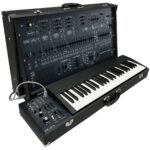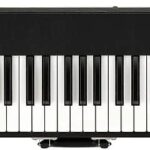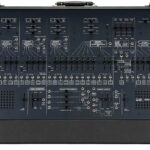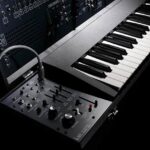The Korg ARP 2600 FS – their high-end reissue of the ’70s classic, which sold out as soon as it was announced – is available again, in limited quantities.
Korg has listed a limited number of brand-new ARP 2600 FS synths in the Korg USA Reverb Direct Shop for $4,499.99.
Korg introduced the ARP 2600 FS at the 2020 NAMM Show:
Here’s their official intro video:
Here’s what Korg had to say about the ARP 2600 FS at the time:
This limited-edition release is a loving reproduction of the 2600, handcrafted in Japan and includes USB and DIN-style MIDI connections, XLR audio outputs, plus the improved ARP 3620 Duophonic Keyboard with an added arpeggiator / sequencer. Your new ARP 2600 will arrive in a custom-branded hard shell case, complete with casters.
Pricing and Availability
The Korg APR 2600 FS is available now in limited quantities for $4,499.99 USD.







expensive knockoff
It is not a knock off when it is under licence from ARP.
Well, kind of yes snd no. Korg claimed the trademark as abandoned and used it. (You can get ownership of an abandoned trademark by using it.) that being said, from all appearances, Korg has stayed very true to the originals in their reissues, only adding modifications like midi that ARP would have done had the company survived.
How can that possibly be when there is no “ARP”? The last company to have purchased rights from ARP was CBS musical instruments division. They did the Chroma, and that had an ARP logo on it. So, are you saying that Korg licensed the logo from CBS?
To correct myself … The Chroma that was released by the Fender division of CBS Musical Instruments didn’t have the ARP logo on it, nor did it even mention ARP anywhere on the instrument. Sorry about that!
Who owned the ARP name after CBS? Who had the name before Korg? Does Korg own the ARP name now, or are they licensing the name?
David Friend (the co-founder of ARP) was involved in the development of the Korg Odyssey (but Alan Pearlman was still alive at the time). My guess is that the “ARP” name was godfathered to Korg, but I don’t think that a “name” can be owned. Logos, on the other hand, can be copyrighted, and the logo is, suspiciously, absent from the Odyssey but is present on the Korg 2600. Since they are using it, I guess Korg has obtained the rights to do so. Since the Chroma (or the Polaris) didn’t use either the name or the logo, my guess is that CBS never acquired the rights to them, and the deal with ARP was only for the prototype of the ARP Chroma.
Great, right? With this, the even more expensive original, three cheaper knockoffs, and a bunch of VSTs without a box, there is now an option for everyone.
that’s a brilliant way to look at it.
Not a knockoff, a faithful recreation.
Exactly, if they have the ARP logo on it, its reasonable to to think they’d paid licensing fees of some sort. People put work into designing things and have a right not have their work stolen by companies that have a powerful legal team geared up to game the system. Not naming any names of course…
What I find odd is that the logo appears on the Korg 2600 but not the Korg Odyssey. While Korg made a big deal of their collaboration with David Friend (co-founder of ARP) on the Odyssey clone, I haven’t seen Friend’s name associated with the Korg 2600 knockoff. Also, the Odyssey was released when Pearlman was still alive, but the first release of Korg’s copy of the 2600 was after he was dead. Coincidence?
The Mk3 doesn’t have the Arp logo anywhere except the serial number sticker. The Korg black/orange version matches that, with no logo on the front.
The I and II had it on the front and back. The black/gold and white Korg versions feature that logo, front and back.
Contrary to whatever you are trying to say, the Korgs match the look of the originals.
All the special edition full size Odyssey’s have the Arp logo and name on them. Only the full size replicas came like that. The Odysseys most people own from Korg are not the special edition ones that only contain the Korg logo.
Korg owns the ARP trademark because they bought it in bankruptcy proceedings in the ’80s. They have no more connection to the creation of the 2600 than anyone else.
Faithful is a matter of opinion. Have you seen inside one? Take a look https://www.matrixsynth.com/2020/03/korg-arp-2600fs-goes-surface-mount.html
Yeah not a “faithful” recreation
It doesn’t surprise me – it would have ended up costing three times the price if it were hand soldered from through-hole components
Arguably SMT is more stable, less noisy, more energy efficient and cheaper
maybe those things make a “better” 2600 – maybe they don’t
Time will tell
Thanks for posting this Angstrom. I think the takeaway is that the assembly and the casing itself on the FS model are the largest expenses, if i read that correctly.
Using surface mount parts doesn’t make a synth any less faithful to the original from a circuit standpoint or a sound standpoint, as long as they are using equivalent parts.
The Korg ARP 2600 and the Sequential Prophet-V are essential mk4 releases of the original designs, and most people recognize them as such.
The only companies I can think of that are doing board-level replicas or reissues, where the circuit boards match the vintage originals, are Moog and DinSync’s Paul Barker. They’re both replicating the original boards, using new old school parts to the extent possible. You can’t do this with anything other than boutique products, it’s WAY too expensive.
Torgood, I agree because the Korg Odyssey and Prophet 5v4 both sound incredible and very close to the originals. Surface mount is just harder to repair and replace parts. For the record the Antonus 2600 uses through-hole parts if one thinks it’s that important. Using components that are different because the old ones are unavailable is part of it, but i think the largest differences between good and bad analog recreations, are changes the engineers make to the actual circuits for cost reasons. This was done back in the day too, including with the original 2600. Heck, even Bob Moog did that with the Voyager.
It boggles the mind that anybody would purchase this at ten times the cost of the Behringer clone. I mean it’s a Korg, not an ARP. What’s next, a Roland version for $7k?
4k is pretty cheap to get the real thing, especially if its something that you’ve been lusting after half your life, which a lot of people have.
Also, it’s reasonable to think that the value is likely to go up on these. That’s not going to happen with the knockoffs.
The knockoff versions will be great, though, for people that don’t care if it sounds like an original, is built like the original, or has the same features as the original. The Behringer 2600 mkII version are better than the mk1’s, but still don’t sound like the original.
If you’ve got the money, why would anybody settle for a ‘good enough’ knockoff?
As Angstrom has alluded, this is far from the “real thing”. If I had to guess, based on what they did with the Model D and Solina, I would believe that the Behringer is a more faithful knockoff (even though I never looked inside one), no matter what the silkscreen logo on the outside might say. I never bought a 2600 back in the day because there was nothing that it offered that I didn’t already have with my EML-101 and a couple EML-200s. I had access to one in the electronic music lab at the university I was attending at the time, and I worked on it quite a lot. I was never particularly impressed by its sound, because it sounded really generic, even for synths available in 1975. The patching flexibility was unique for packaged monosynths at the time, but when you compared it to what you had access to with an EML-101 and two EML-200s, it really wasn’t all that much (especially for the price at the time). This Korg thingie is just another example of logo lust. Suckers are born every minute I guess.
“…but still don’t sound like the original.”
Based on the Sweetwater and Amazon reviews by owners, it would seem that many would disagree with that comment, including those who owned an original 2600.
Nobody but an idiot would put their trust in Amazon reviews. Not sure if Sweetwater reviews are as bogus, but I’d assume that they are suspect also.
You might want to think through why Behringer had to introduce a mkII version of their 2600, just a few months after they introduced the mkI.
Multiple people independently identified significant errors in Behringer’s 2600 design that result in it performing and sounding very different than the original. Behringer admitted as much, saying that they had upgraded the parts on their Grey/Blue Meanie versions to be more accurate, along with replacing the fake spring reverb with a real one.
The new reverb still doesn’t sound anything like the original. My understanding is that Behringer wouldn’t have been able to fit the correct reverb physically into their case design.
They are still selling the orange and black 2600, which has all the errors and fake spring reverb.
The Behringer 2600 is a good synth and a good value, but it’s not an accurate recreation of the functionality or sound of the original and any informed reviewer and buyer should recognize that.
“Nobody but an idiot would put their trust in Amazon reviews. Not sure if Sweetwater reviews are as bogus, but I’d assume that they are suspect also.”
LOL. You can say that about anything. Nobody but an idiot would put their trust in Trip Advisor reviews. Nobody but an idiot would put their trust in Yelp reviews. Etc. etc. etc.
Dude, an original, working ARP 2600 typically goes for $12 grand and up. And the new Korg FS 2600 reissue is how much? $4.5 grand. 99% of music listeners can’t tell and don’t care about any sonic differences between an original 2600, a Korg 2600, or a B word 2600, especially in a mix. For most people, the millions who create music in home studios, the differences aren’t worth $$$ thousands more. $$$ For those who have the Benjamins and want an original ARP 2600 (and the potentially huge repair bills if/when something goes wrong with it) or a Korg 2600 reissue, have at it. For those who can afford an original ARP 2600 or a Korg 2600 reissue but don’t want to spend that amount of money on a synth and for those who can’t afford a Korg 2600 reissue, the B word 2600 is a more than adequate alternative.
Regarding the later B word 2600 “mkII version,” is there all that much of a difference when compared to the “mk1?”:
https://www.youtube.com/watch?v=7OGgBPVMoCQ
Babe, it’s literally Behringer who marketed the mkII version as being a significant sonic improvement over the mkI version. And synth engineer Rob Keeble, who worked on the 2600 project, said that the filter and the reverb tank on the mkII version are a lot closer to real 2600s.
If you just want something that’s close enough for horseshoes and hand grenades, though, you’re not going to care.
Again, if you are purchasing a synth for its sound, and not for its ergonomics and logo, it really doesn’t make much difference in the case of the 2600. There wasn’t really anything about the sound of a 2600 that was unique to it, except that it had all of the included modules necessary to make those sounds. People are enamored in the 2600 for what it was in the history of synths, not because of how it actually sounded. In the early 70s, the ARP 2600 was a very unique and powerful synth. Today, it is a mediocre monosynth that sounds ho-hum (even it it sounded today exactly like it did when it was introduced), especially compared to what you can construct for that kind of money from Eurorack modules.. My guess is that all of the clones (including Korg’s) will sound about the same and will probably sound indistinguishable from the original ARP.
It’s not “good enough”, Behringer’s 2600 is a great synthesizer. Take a look at Ralph Baumgartl’s various videos on YouTube. It’s not only good-sounding to a handful of synthesis veterans, but also an amazing tool to learn synthesis on, figure out modularity on, and it’s a steal. The Gray Meanie even looks pretty cool (of course it’s based on a pre-existing synth, but still). It’s not as beautiful as the Korg knockoffs, but it’s amazing we can attain 2600s for this price in this time period, and it seems silly to pass it up.
The Behringer 2600 is not ‘great’ if you want a real 2600 – one that’s full size, has the interface of a 2600, has the speakers of a 2600, has a large spring reverb, and sounds like a 2600.
It’s “good enough” if you’re happy with a knockoff 2600.
Behringer buyers should get over the idea that knockoffs can’t be good synths. I’ve got a Behringer D and VC340, and they 100% are knockoffs and feel like cheap knockoffs, but they’re also good synths for the money and I’m happy that I bought them.
PS: When people call the reissues from Korg, Moog or Sequential ‘knockoffs’, or ask why anybody would buy these reissues when there’s a Behringer alternative, ya’ll just sound insecure AF about your Behringer purchases. Be happy about your cheap synths, you don’t have to justify them to yourself!
I take a bit of offense from that statement. I didn’t purchase my Model D because it was “cheap”, I bought it because when I heard it the first time my brain recognized it as an authentic Minimoog. That’s something I can’t say about any other knockoffs (including Moog’s last two) or computer emulation (although I nave to admit Softube’s is becoming really close). I have nothing to justify for myself in purchasing the Model D, having owned three vintage Minmoogs over the years. The people who have to justify something are those who purchased the Moog reissues thinking that they have purchased something that sounds like a vintage Minimoog!
You missed my point completely. “I’ve got a Behringer D and VC340, and they 100% are knockoffs and feel like cheap knockoffs, but they’re also good synths for the money and I’m happy that I bought them.”
Like I said, be happy about the fact that cheap synths are available now.
When you start suggesting that people need to justify buying a real Minimoog or 2600 or Prophet, though, you sound clueless and insecure.
The idea hangs around that the B2600s just don’t have the same moxie as the theoretical real ARP 2600, in terms of raw tone power and sweet harmonic kind of stuff. The B2600 is an amazing value and I guess it sounds close enough to the original, but i wouldn’t say it has raw tone power or sweet harmonics, which i have definitely experienced with other original ARPs. The thought must be, the FS looks exactly like an original, therefore it has the same sonics and could be worth paying an extra $3500. My understanding is this really is the same sonics as the KARP 2600M, besides a larger reverb tank (i think), which makes the M possibly the one to get if you’re just going for accuracy and not aesthetics.
Wonder if these are any different than the last batch Korg produced
Not even two 1970s 2600s will sound the same. Rejoice.
Yes not it’s only available in the US. I was going to purchase but I’m in Aus. What a joke.
I have an ARP 2600M. It’s an ARP 2600- no doubt. Not a knockoff or replica. If the original makers of synths, back in the day, could have gotten their hands on surface mount technology and manufacturing techniques they would have done it in a second… lower heat? better stability? less expensive and faster (and more accurate) manufacturing? The inventors of synths were engineers, not fanboys, they would have done exactly what is being done now.
But most importantly is what it *sounds* like… I played original ARP 2600s back when they could be bought new… This is the real deal. Yes its newly made- but it IS an ARP 2600. Ears don’t lie. Go out and support these businesses who are engaging in this divine labor of love by reissuing extinct instruments… TipTop Buchla, Behringer, Korg, Moog… all of them… Go put your money where your ears are and support this unimaginable renaissance of modular synthesis.
With all due respect, the Korg ARP 2600M is a fraction of the size of the original 2600s and uses smaller 3.5mm jacks and cords, how is it, “not a…..replica?”
The original 2600 and Korg 2600fs also use 3.5mm jacks. They never used 1/4″, if that’s what you think.
The original ARP 2600s used Tini-Jax connectors, which are slightly larger than 1/8″ jacks and 3.5mm jacks. Korg changed the jack size to 3.5mm on their 2600 reissues / replicas. 3.5mm cords are loose on an old 2600.
Wow, I never knew that. Interesting!
Yes, but that makes about as much difference as would supplying power to it with a $3000 mains cable.
As a KARP 2600 FS owner I must say that while it isn’t cheap, it’s an extremely enjoyable synth that sounds great. The “enjoyable” part is a huge deal to me that I don’t always find with instruments. In my world a synth that’s fun to play will be used, and is money well spent.
Your point is a good one, but how do you know you wouldn’t feel exactly the same way about the Behringer if you had purchased one of those instead?
And it sold out in four days. No chance for those of us who don’t have $5,000 just sitting around ready to burn at a moment’s notice. Shame on Korg for making this so difficult as I have zero interest in buying the M version. Will not be buying from this company in the future.
Are you complaining that people who don’t have $5,000 can not buy things that cost $5,000? That’s hardly Korg’s fault, that’s just how money works.
I’m not complaining about that at all. What I AM complaining about is that if these units sold out in four days, Korg either completely misjudged the market demand, or worse, they kept the supply artificially low. I would like to think that most people would do what I did and at least take a couple days to think about what is effectively a $5,000 vanity purchase before pulling the trigger. At the very least they could have announced an on-sale date so those of us could plan for such a large purchase. I could understand selling in out in two or three weeks, but four days? give me a fucking break.
Also, you could have one that is just as serviceable for about $4500 less if you buy the Behringer. A loss for Korg, maybe, but definitely a gain for Uli.
Totally get your point, John. I just refuse to support Behringer because I don’t enjoy playing their products. I’m fine with others who choose to go that route, but it just isn’t for me. And yes, that means I am willing to pay a premium for certain designs that Behringer is selling at a much lower price point.